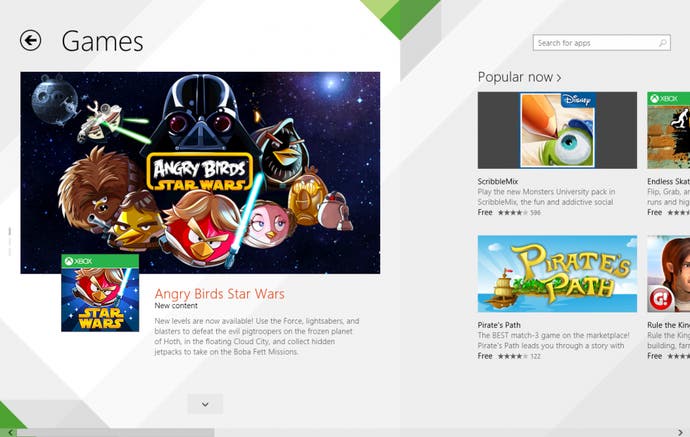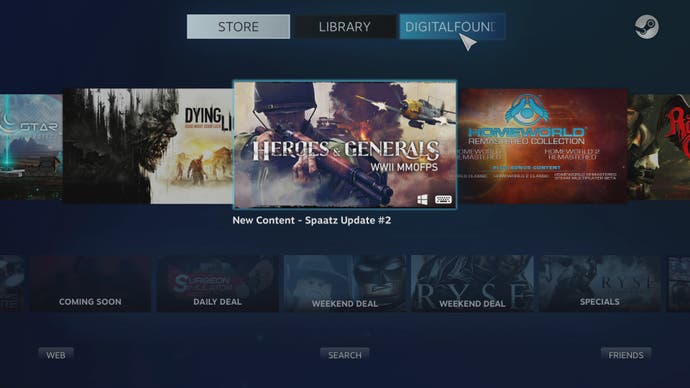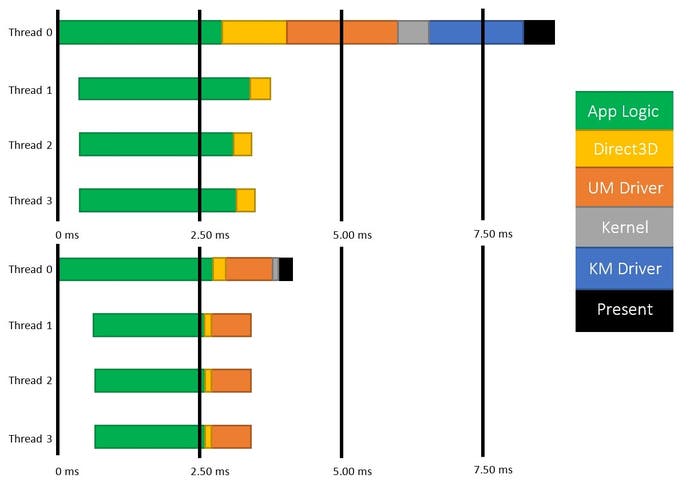GDC preview: Windows 10 vs SteamOS
Digital Foundry explores two competing visions for the future of PC gaming.
Less than one month from now, the Game Developers Conference - GDC - kicks off in San Francisco. Aside from the reveal of Sony's Project Morpheus VR concept last year, the show has been short of game-changing announcements in recent times - but this year's event promises to be different. A revitalised Microsoft will continue its drive to promote Windows 10 for gaming, while Valve is set to relaunch its delayed Steam Machine platform. We will be presented with two very different visions for the future of PC gaming, and while the specifics of the upcoming clash remain shrouded in mystery some nuggets of information are starting to come to light.
Valve's pursuit of a truly open PC platform led to the beginning of the Steam Machine initiative, prompted by Microsoft's plans to erect a massive walled garden in Windows 8 in the form of the Windows Store. Nothing stopped users from running their own code on the OS of course, but the introduction of a Microsoft app store with Redmond in complete control was a warning shot to Valve, whose Steam platform relies on Windows remaining an open platform. Its response? To put serious resources into a Linux-based PC gaming alternative.
"The big problem that is holding back Linux is games. People don't realise how critical games are in driving consumer purchasing behaviour," Valve's Gabe Newell said. "We want to make it as easy as possible for the 2,500 games on Steam to run on Linux as well. It's a hedging strategy. I think Windows 8 is a catastrophe for everyone in the PC space. I think we'll lose some of the top-tier PC/OEMs, who will exit the market. I think margins will be destroyed for a bunch of people. If that's true, then it will be good to have alternatives to hedge against that eventuality."
Some might say that Newell's initial predictions turned out to be alarmist nonsense - Steam itself continues to thrive on Windows and Microsoft must surely realise the importance of the Valve platform for its OS - but we wouldn't be so quick to write off his concerns. At the time he made his comments, the Valve man had no way of knowing that Microsoft's attempts to break into the mobile market would fail quite so badly, and without that crucial support, the Windows Store failed to gain traction. While there's no doubt that Windows 10 will run Steam just fine, what's clear is that Microsoft hasn't given up on the walled garden despite the Windows 8 set-back - indeed, it's giving it another shot and its potential is actually rather compelling. This time it's called Universal Apps and it's as enticing as it is concerning to the PC's open platform status.

"Whether it's building a game, or a line of business application, there'll be one way to write a universal application that targets the entire product family," Microsoft Executive VP Terry Myerson revealed at a Windows 10 event last October, revealing that developers embracing Windows 10 could create games and apps that run on PCs, phones, tablets - and Xbox One.
It's a compelling proposition for developers - after all, the ability to instantly deploy their work on a vast range of platforms is obviously attractive. While the old Windows Store failed to gain traction, the ability to add in an Xbox One userbase currently sitting at 10 million and rising all the time could make all the difference. Meanwhile, end-users could be swayed towards the Universal Apps initiative, knowing that a single purchase should work across multiple platforms. The big disadvantage for all parties is the fact that it strengthens Microsoft's aim to control of Windows, putting its open platform status into question. And it's not just Microsoft that's looking to add limitations to an open platform - with the latest revisions of OSX, Apple is also starting the process of limiting the user's ability to run programs not downloaded from the iTunes app store, or at the very least, to make it more difficult.
Windows 8 may not have been the catastrophe that Newell predicted but the failure of the Windows Store clearly hasn't diminished Microsoft's enthusiasm for taking control of its OS. In our opinion, Gabe Newell's hedge strategy with Linux is just as relevant with the arrival of Windows 10 as it was with its predecessor.
"In order for innovation to happen, a bunch of things that aren't happening on closed platforms need to occur," Newell said. "Valve wouldn't exist today without the PC, or Epic, or Zynga, or Google. They all wouldn't have existed without the openness of the platform. There's a strong temptation to close the platform, because they look at what they can accomplish when they limit the competitors' access to the platform, and they say 'that's really exciting'. We are looking at the platform and saying, 'We've been a free rider, and we've been able to benefit from everything that went into PCs and the Internet, and we have to continue to figure out how there will be open platforms'."

All of which brings us back to the Linux-based SteamOS, the Steam Machines and the bespoke controller - all of which we expect to see showcased next month at GDC. It's fair to say that the challenge facing Valve in launching this new platform remains as difficult as it always has been - if not more so. The firm's initial SteamOS announcements were perfectly timed: Windows 8 initially failed to gain favour with gamers, while internal development on the DirectX 11 API was stalling, with many developers eyeing SteamOS's OpenGL as an alternative, not least for its enviable cross-platform support (it works on Linux, Windows, Mac and mobile).
However, a number of setbacks have resulting in Microsoft upping its game. Windows 10 itself looks like an immense improvement over its predecessor generally, but specific areas highlight both the need for the SteamOS hedge bet, plus the level of competition the Microsoft OS represents. The development of the appealing, if concerning, Universal Apps is a direct consequence of the firm's failure in competing against iOS and Android, and its inability to make the Windows Store indispensable to PC owners. Meanwhile, the emergence of the Mantle API and disappointing Xbox One graphics performance has resulted in a renewed focus within Redmond on whipping DirectX into shape. We don't expect the forthcoming DX12 to change the Xbox One landscape to a great degree, but its appeal in the PC space is considerable across both desktop and mobile computing.
It's DirectX 12 in particular that has clearly caused headaches for SteamOS. The old Microsoft would have released Windows 10 as a premium upgrade, and developers would have been forced to produce DX11 and DX12 versions of the same game in order to get it running on as many PCs as possible. The result? Fragmentation and a half-arsed approach to DX12 development - exactly what we saw with DX11 before the arrival of Xbox One finally consigned its predecessors to the dustbin. Windows 10 is a free upgrade, solving that issue at a stroke, with the same API deployed on Xbox One, streamlining development still further. It'll be costly for Microsoft, but the API fragmentation issue is solved. In the meantime, many of the core enhancements in the new Microsoft API are not a part of OpenGL, by extension making SteamOS less desirable to developers.

OpenGL has a reputation for getting great results at a lower level - just like Mantle and DX12 - but much of this is derived from this Approaching Zero Driver Overhead GDC presentation, with some remarkable results achieved using Nvidia OpenGL extensions. However, our feedback from development sources is that it's extremely difficult to work with and not in a state where game-makers can ship titles with it. In effect, the emergence of DX12 threatens to leave SteamOS behind, with the latest OpenGL effectively on level-pegging with the older DX11.
Valve is wise to this and is making all the right moves. One element we can confirm about the firm's upcoming GDC offensive is the reveal of a new graphics API from OpenGL makers, Khronos, that has obvious involvement from Gabe Newell and company. glNext is described as an "upcoming cross-platform graphics API designed for modern programming techniques and processors. glNext will be the singular choice for developers who demand peak performance in their applications." A sponsored session from Valve, support at the presentation is impressive, with representation from Epic (Unreal Engine) and Unity, not to mention DICE's Johan Andersson - a key architect behind AMD's Mantle API and whose work appears to have been invaluable in shaping DirectX 12.
Also present at the event is Oxide Games' graphics architect, Dan Baker. Oxide produced the Star Swarm stress test Mantle demo, and has a deep understanding of the API. Way back in May 2014, Baker produced a fascinating blog on why Mantle and DX12 are so important, and it also serves as a great primer on what the technology is capable of, and how it can change gaming. It's an old blog now, but somewhat prophetic in highlighting the need for glNext.

"Oxide has a strong interest in supporting platforms beyond Windows," Baker wrote. "Our hope is that Mantle be a call to arms to bring an industrial-strength API to such platforms as SteamOS, Linux, Android and MacOS. The biggest problem for us moving to other platforms is the relative weakness of the graphics software... from a business standpoint, it makes little sense to rely on Microsoft doing the right thing."
At the very least, the arrival of glNext should ensure that SteamOS can compete with - or maybe even surpass - DirectX 12 in terms of GPU features and low-level utilisation. Certainly the involvement of DICE's Johan Andersson in particular suggests that this should be the case, ensuring that SteamOS remains competitive.
However, on a higher, more general level, Valve has to make the case that SteamOS is a viable alternative to Windows. There's a genuine danger that it won't receive the support it needs to flourish, and referring to it as a 'hedge bet' makes the platform look like a fallback position rather than the fully open vibrant platform competitor to Windows it needs to be.
"Windows 8 was like this giant sadness," Newell once told The Verge. "It just hurts everybody in the PC business. Rather than everybody being all excited to go buy a new PC, buying new software to run on it, we've had a 20+ per cent decline in PC sales - it's like 'holy cow that's not what the new generation of the operating system is supposed to do.' There's supposed to be a 40 per cent uptake, not a 20 per cent decline, so that's what really scares me. When I started using it I was like 'oh my god...' I find [Windows 8] unusable."
It's been over two years since Gabe Newell wrote off Windows 8. In that time we've seen the OS transform into a more streamlined version of its predecessor, with its intrusive tablet interface easily disabled and mostly forgotten for desktop PC owners. It's not a revelation but it's a good, solid OS. We can't help but wonder what Newell makes of Windows 10, and whether he genuinely sees SteamOS as the vehicle for genuine change - beta builds have felt workmanlike and light on features. We understand that the Valve controller has 'gone gold' and will be unveiled in its final form at GDC, and we're likely to see a lot of Steam Machine hardware, but we're going to need to see games - and lots of them - plus a deeply compelling case to convince users that Linux and SteamOS are indeed a viable alternative.









